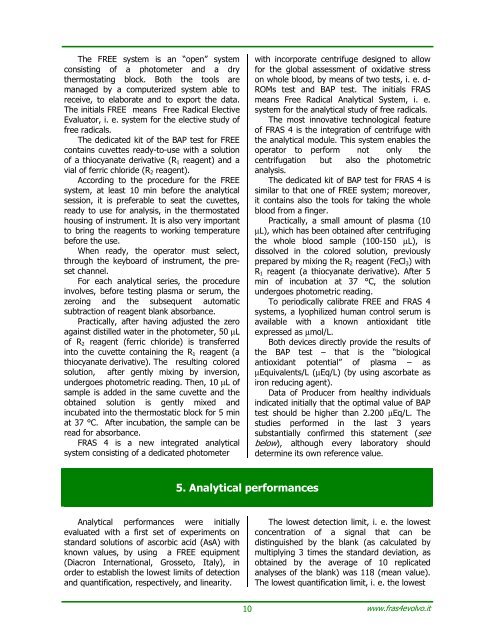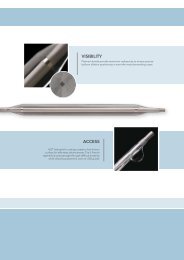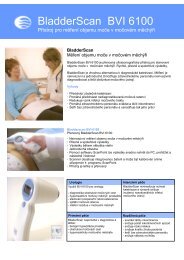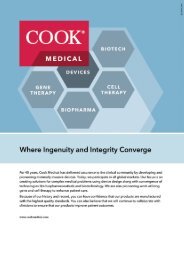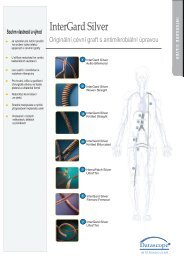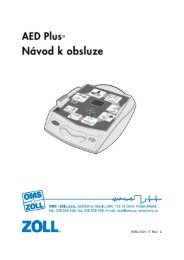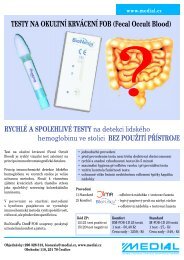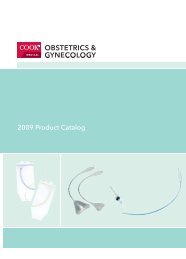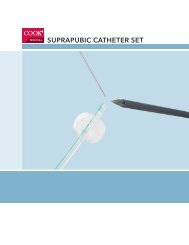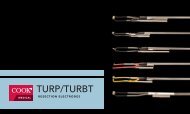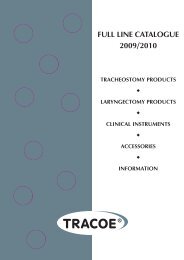The BAP test and the global assessment of oxidative stress ... - Medial
The BAP test and the global assessment of oxidative stress ... - Medial
The BAP test and the global assessment of oxidative stress ... - Medial
Create successful ePaper yourself
Turn your PDF publications into a flip-book with our unique Google optimized e-Paper software.
<strong>The</strong> FREE system is an “open” systemconsisting <strong>of</strong> a photometer <strong>and</strong> a dry<strong>the</strong>rmostating block. Both <strong>the</strong> tools aremanaged by a computerized system able toreceive, to elaborate <strong>and</strong> to export <strong>the</strong> data.<strong>The</strong> initials FREE means Free Radical ElectiveEvaluator, i. e. system for <strong>the</strong> elective study <strong>of</strong>free radicals.<strong>The</strong> dedicated kit <strong>of</strong> <strong>the</strong> <strong>BAP</strong> <strong>test</strong> for FREEcontains cuvettes ready-to-use with a solution<strong>of</strong> a thiocyanate derivative (R 1 reagent) <strong>and</strong> avial <strong>of</strong> ferric chloride (R 2 reagent).According to <strong>the</strong> procedure for <strong>the</strong> FREEsystem, at least 10 min before <strong>the</strong> analyticalsession, it is preferable to seat <strong>the</strong> cuvettes,ready to use for analysis, in <strong>the</strong> <strong>the</strong>rmostatedhousing <strong>of</strong> instrument. It is also very importantto bring <strong>the</strong> reagents to working temperaturebefore <strong>the</strong> use.When ready, <strong>the</strong> operator must select,through <strong>the</strong> keyboard <strong>of</strong> instrument, <strong>the</strong> presetchannel.For each analytical series, <strong>the</strong> procedureinvolves, before <strong>test</strong>ing plasma or serum, <strong>the</strong>zeroing <strong>and</strong> <strong>the</strong> subsequent automaticsubtraction <strong>of</strong> reagent blank absorbance.Practically, after having adjusted <strong>the</strong> zeroagainst distilled water in <strong>the</strong> photometer, 50 µL<strong>of</strong> R 2 reagent (ferric chloride) is transferredinto <strong>the</strong> cuvette containing <strong>the</strong> R 1 reagent (athiocyanate derivative). <strong>The</strong> resulting coloredsolution, after gently mixing by inversion,undergoes photometric reading. <strong>The</strong>n, 10 µL <strong>of</strong>sample is added in <strong>the</strong> same cuvette <strong>and</strong> <strong>the</strong>obtained solution is gently mixed <strong>and</strong>incubated into <strong>the</strong> <strong>the</strong>rmostatic block for 5 minat 37 °C. After incubation, <strong>the</strong> sample can beread for absorbance.FRAS 4 is a new integrated analyticalsystem consisting <strong>of</strong> a dedicated photometerwith incorporate centrifuge designed to allowfor <strong>the</strong> <strong>global</strong> <strong>assessment</strong> <strong>of</strong> <strong>oxidative</strong> <strong>stress</strong>on whole blood, by means <strong>of</strong> two <strong>test</strong>s, i. e. d-ROMs <strong>test</strong> <strong>and</strong> <strong>BAP</strong> <strong>test</strong>. <strong>The</strong> initials FRASmeans Free Radical Analytical System, i. e.system for <strong>the</strong> analytical study <strong>of</strong> free radicals.<strong>The</strong> most innovative technological feature<strong>of</strong> FRAS 4 is <strong>the</strong> integration <strong>of</strong> centrifuge with<strong>the</strong> analytical module. This system enables <strong>the</strong>operator to perform not only <strong>the</strong>centrifugation but also <strong>the</strong> photometricanalysis.<strong>The</strong> dedicated kit <strong>of</strong> <strong>BAP</strong> <strong>test</strong> for FRAS 4 issimilar to that one <strong>of</strong> FREE system; moreover,it contains also <strong>the</strong> tools for taking <strong>the</strong> wholeblood from a finger.Practically, a small amount <strong>of</strong> plasma (10µL), which has been obtained after centrifuging<strong>the</strong> whole blood sample (100-150 µL), isdissolved in <strong>the</strong> colored solution, previouslyprepared by mixing <strong>the</strong> R 2 reagent (FeCl 3 ) withR 1 reagent (a thiocyanate derivative). After 5min <strong>of</strong> incubation at 37 °C, <strong>the</strong> solutionundergoes photometric reading.To periodically calibrate FREE <strong>and</strong> FRAS 4systems, a lyophilized human control serum isavailable with a known antioxidant titleexpressed as µmol/L.Both devices directly provide <strong>the</strong> results <strong>of</strong><strong>the</strong> <strong>BAP</strong> <strong>test</strong> – that is <strong>the</strong> “biologicalantioxidant potential” <strong>of</strong> plasma – asµEquivalents/L (µEq/L) (by using ascorbate asiron reducing agent).Data <strong>of</strong> Producer from healthy individualsindicated initially that <strong>the</strong> optimal value <strong>of</strong> <strong>BAP</strong><strong>test</strong> should be higher than 2.200 µEq/L. <strong>The</strong>studies performed in <strong>the</strong> last 3 yearssubstantially confirmed this statement (seebelow), although every laboratory shoulddetermine its own reference value.5. Analytical performancesAnalytical performances were initiallyevaluated with a first set <strong>of</strong> experiments onst<strong>and</strong>ard solutions <strong>of</strong> ascorbic acid (AsA) withknown values, by using a FREE equipment(Diacron International, Grosseto, Italy), inorder to establish <strong>the</strong> lowest limits <strong>of</strong> detection<strong>and</strong> quantification, respectively, <strong>and</strong> linearity.<strong>The</strong> lowest detection limit, i. e. <strong>the</strong> lowestconcentration <strong>of</strong> a signal that can bedistinguished by <strong>the</strong> blank (as calculated bymultiplying 3 times <strong>the</strong> st<strong>and</strong>ard deviation, asobtained by <strong>the</strong> average <strong>of</strong> 10 replicatedanalyses <strong>of</strong> <strong>the</strong> blank) was 118 (mean value).<strong>The</strong> lowest quantification limit, i. e. <strong>the</strong> lowest10www.fras4evolvo.it


